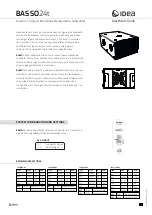
screen, computer discs, audio and video tapes, swipe cards...)
at least 1.5 ft (50 cm) away from the speaker. Cabasse centre
speakers or the ones marked «TV» are not concerned with
this, being magnetically shielded.
Positioning speakers in a room
Optimal positioning for a 2.1
or stereo with a subwoofer system
For a stereo listening with 2 speakers or 2 satellites and 1 sub-
woofer, we recommend you to place the subwoofer in the
front listening area. The placement of the subwoofer against
a wall reinforces the low frequencies and limit the reflections
from 80 to 200 Hz. However to obtain the best results, it is
always necessary to carry out tests according to the acoustic
of the room.
Optimal positioning for a 5.1
or home theatre system
Setting up a multi-channel Audio-Video system requires great
care when positioning the specific AV speakers.
■
The centre speaker should be placed as close as possible to
the screen and where it sounds best from your listening spot
while offering the optimal picture/dialogues cohesion. Theo-
retically, the screen should be located within a virtual triangle
formed by the acoustical centres of the main speakers and the
centre speaker. Practically speaking, this means that the prin-
cipal speaker should be placed above the screen if the main
speakers are below it, and below the screen if the main spea-
kers are above. The centre speaker should also, if possible, be
set slightly back from the others, so that it is located at the same
distance from the listener as the main speakers.
■
The rear speakers or surround should be placed against the
side walls, at listening height. They should not be positioned
far behind the listening zone.
■
The subwoofer should be placed in the front listening area,
its position against a wall reinforces the extreme low register and
limits the reflections between 80 and 200 Hz. However to
obtain the best result, it is always necessary to carry out tests
according to the acoustics of the room.
Your AV processor enables the adjustment in level and delay of
each of the 5/6/7 channels of your system. Fine-tuning is neces-
sary to obtain a perfect sound stage.
Turn off all the amplifiers before interconnecting them to the
loudspeakers. In order to connect loudspeakers properly, it is
most important to keep in mind the following two factors:
cable section and phase.
CONNECTION
Cable section
To get the full sonic
potential of Cabasse
loudspeaker s and
avoid power losses,
the cables connecting
the speakers to the
power amplifier must
have the lowest possible electrical resistance. To help you in
choosing the correct cable gauge, follow diagram.
Phase
In order to maintain the phase
relationship and frequency balan-
ce of the loudspeaker system, both
loudspeakers must be properly
connected to the power amplifier.
When properly connected, the
cones of the drivers of both loud-
speakers will move in the same
direction when driven by identi-
cal speakers will move in the same signals. If the cones move in
opposite directions, the resulting out of phase signals will crea-
te a perceptible power loss, particularly in the low frequencies.
The stereophonic message will also be degraded. Amplifier and
speaker manufacturers typically indicate connection polarity in
one of two ways: red and black or plus and minus. In either
case, always connect red or plus to red or plus and black or
minus to black or minus. Connections should be identical for
both channels. To check that the speakers are in correct phase,
switch the system to mono while music is being played. if the
amplifier does not have a phase inversion switch, it will be neces-
sary to change over the connections on one only of the loud-
speakers. If in correct phase, the image should be distinctly loca-
ted between the loudspeakers with a slight loss of bass and low
midrange level. If the image is confused and not centrally loca-
ted and there is a drastic loss of bass and low midrange level,
recheck your connections.
3 possibilities are offered to connect the subwoofer with your
system :
■
the one requiring the use of the LOW LEVEL INPUT terminals
6
and shielded coaxial RCA-RCA connectors,
■
the one requiring the use of the BALANCED INPUT terminals
7
and shielded coaxial XLR-XLR connectors,
■
the high level one requiring the use of the speaker HI LEVEL
INPUT
5
and eventually the HI-LEVEL OUTPUT
4
terminals,
and standard loudspeaker cables.
The inputs are stereo ones, the mix of the L (left) and R (right)
low frequencies being done by the amplifier of the subwoofer.
If the input signal is already mono, only one input L (left) or R
(right) should be used.
The 3 input modes can be used simultaneously in parallel for ins-
tance in a multichannel configuration.
Connections to the LOW LEVEL INPUT
If your preamplifier or your integrated amplifier is fitted with a
stereo low-level output, then connect its L (left) and R (right) out-
puts to the L (left) and R (right) LOW LEVEL INPUTS
6
of
the subwoofer using a RCA-RCA cable.
If your amplifier offers a one mono output, connect it to either
the L (left) or the R (right) subwoofer LOW LEVEL INPUTS
6
.
Connections to the BALANCED INPUTS
If your preamplifier or your integrated amplifier is fitted with a
stereo balanced low-level output, then connect its L (left) and R
(right) outputs to the L (left) and R (right) BALANCED INPUTS
7
of the subwoofer with XLR-XLR interconnect cables. If your
amplifier offers a one mono output, connect it to either the L
(left) or the R (right) subwoofer BALANCED INPUTS
7
.
e n g l i s h
Lenght between
recommanded
amplifier and loudspeakers
section
4.5 m
1.5 mm
2
6 m
2 mm
2
7.5 m
2.5 mm
2
9 m
3 mm
2
12 m
4 mm
2
Attention,
before operating the unit,
be sure that the
operating voltage
of your unit is identical
with that of your local
power voltage.
Cab notice Sub-03 _v2:Cab notice Sub-03 13/11/09 12:58 Page7























